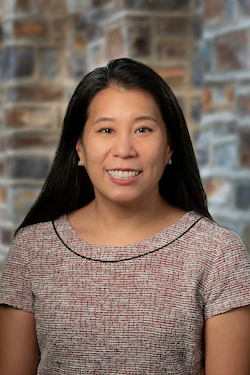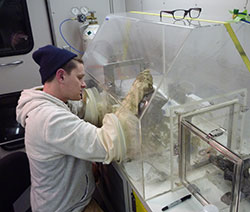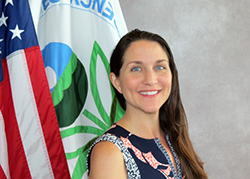Biogeochemical Interactions Affecting Bioavailability for in Situ Remediation: Session III - Mercury Bioremediation and Biotransformation Under Varying Biogeochemical Conditions
Sponsored by: NIEHS Superfund Research Program
Archived: Monday, May 20, 2019
Biogeochemical Interactions Affecting Bioavailability for in Situ Remediation: Session III - Mercury Bioremediation and Biotransformation Under Varying Biogeochemical Conditions
2019-05-20
NIEHS Superfund Research Program
This webinar series will feature individual research projects funded by the NIEHS Superfund Research Program (SRP). In 2013, the SRP initiated a targeted research program to better understand how contaminants in the environment are affected by complex biological, geological, and chemical processes. By understanding these complex interactions, we are better equipped to optimize remediation strategies and, therefore, improve science-based decision making for site management, priority-setting, and remedy selection. The individual research project grants support problem-solving research on the mechanisms of biogeochemical interactions that may impact remediation of contaminated soil, sediment, surface water, or groundwater.
In session 3, we will hear from SRP-funded individual research projects at Duke University and University of Maryland-Baltimore County.
At Duke University, scientists led by Heileen Hsu-Kim, Ph.D., are studying sediment dwelling microorganisms that methylate mercury, and identifying factors that may be used to control and reduce toxic methylmercury production. The research is focusing on strategies to measure mercury bioavailability and biomethylation potential in sediments. Their work has demonstrated that passive samplers such as diffusive gradient in thin-films (DGT) can be used to predict the bioavailable fraction of mercury to methylating organisms. The work also evaluated biomolecular techniques targeting microbes carrying the hgcA and hgcB genes specific for mercury methylation. Together, these methods can be used to determine mercury biomethylation potential in sediments and help site managers understand the controlling factors leading to methylmercury risk at field sites. For more information, please visit: Biogeochemical Framework to Evaluate Mercury Methylation Potential During in-situ Remediation of Contaminated Sediments
At the University of Maryland Baltimore County, Upal Ghosh, Ph.D., leads a research team to develop an empirical model of the factors influencing mercury and methylmercury bioavailability in contaminated areas. Using this model, they plan to identify biogeochemical characteristics that make sites suitable for remediation with sorbent remediation approaches, such as activated carbon amendments. The researchers will also design sorbent amendment/thin capping strategies that reduce methylmercury bioavailability. The main study site is a salt marsh in Berry's Creek, N.J., where they are conducting a field trial of in situ sorbent remediation using activated carbon and also evaluating the relative efficacy of a wider range of black carbons. For more information, please visit: Development of in-situ Mercury Remediation Approaches Based on Methylmercury Bioavailability
Accessibility, Recording, and Content Disclaimer
Rehabilitation Act Notice for Reasonable Accommodation
It is EPA's policy to make reasonable accommodation to persons with disabilities wishing to participate in the agency's programs and activities, pursuant to the Rehabilitation Act of 1973, 29 U.S.C. 791. Any request for accommodation should be made to Sara Amolegbe at 919-213-4906 or sara.amolegbe@nih.gov, preferably one week or more in advance of the webinar, so that EPA will have sufficient time to process the request. EPA would welcome specific recommendations from requestors specifying the nature or type of accommodation needed. Please note that CLU-IN provides both alternate phone call-in options and closed captioning for all webinars, and requests for these specific accommodations are not necessary.
Webinar Recording
By participating in this CLU-IN webinar, you automatically agree to authorize recording of audio and visual content presented during this live event and consent to subsequent use of this recording in the public domain by the U.S. Environmental Protection Agency. This recording may include questions, comments and poll responses provided by you during the live event in addition to your name, voice, image or likeness. This recording will be made available after the conclusion of the live event as part of the CLU-IN webinar archives, and will remain available indefinitely. If you do not wish to consent to the recording, please do not join the live event, and contact Jean Balent at 202-566-0832 or balent.jean@epa.gov to discuss your concerns.
Content Disclaimer
This webinar is intended solely to provide information to the public. The views and opinions expressed as part of this webinar do not necessarily state or reflect those of the U.S. Environmental Protection Agency. It is not intended, nor can it be relied upon, to create any rights enforceable by any party in litigation with the United States, or to endorse the use of products or services provided by specific vendors. With respect to this webinar, neither the United States Government nor any of their employees, makes any warranty, express or implied, including the warranties of merchantability and fitness for a particular purpose, or assumes any legal liability or responsibility for the accuracy, completeness, or usefulness of any information, apparatus, product, or process disclosed, or represents that its use would not infringe privately owned rights.
Presenters:
 Heileen Hsu-Kim, Ph.D., Duke University (hsukim@duke.edu)
Heileen Hsu-Kim, Ph.D., Duke University (hsukim@duke.edu)
Heileen (Helen) Hsu-Kim, Ph.D., is a Professor of Civil & Environmental Engineering at Duke University. Prior to joining the Duke faculty, Dr. Hsu-Kim completed her B.S. degree in Environmental Engineering at MIT, and M.S./Ph.D. degrees in Environmental Engineering at UC-Berkeley. Dr. Hsu-Kim's expertise area is aquatic geochemistry and her research focuses on trace metals and their biogeochemical transformations in environmental systems. Recent work from Dr. Hsu-Kim's research team include studies mercury pollution in the environment, the impacts of artisanal gold mining in Latin America, new methods to quantify personal exposures to toxic chemicals in the ambient environment, and technologies to recover rare earth elements from wastes.
 Upal Ghosh, Ph.D., Department of Chemical, Biochemical, and Environmental Engineering at the University of Maryland Baltimore County (ughosh@umbc.edu or 410-455-8665)
Upal Ghosh, Ph.D., Department of Chemical, Biochemical, and Environmental Engineering at the University of Maryland Baltimore County (ughosh@umbc.edu or 410-455-8665)
Upal Ghosh Ph.D., is a professor in the department of Chemical, Biochemical, and Environmental Engineering at the University of Maryland Baltimore County. He has a B. Tech in Chemical Engineering from the Indian Institute of Technology, Bombay, India, an M.S. and Ph.D. in Civil and Environmental Engineering from the State University of New York at Buffalo and completed a Postdoc at Carnegie Mellon University and worked as a Research Associate at Stanford University. He is currently the Principal investigator for the Development of in-situ Mercury Remediation Approaches Based on Methylmercury Bioavailability NIEHS R01 grant and recently completed and NIEHS R01 grant titled Combining Bioavailability Assays with Modeling to Predict PCBs in Fish after Remediation. His group performs research in environmental engineering and science with a focus on the fate, effects, and remediation of toxic pollutants in the environment. They use multidisciplinary tools to investigate exposure and bioavailability of organic and metal contaminants to organisms and this new understanding is used to develop novel remediation technologies and site-specific remediation goals. Recent projects have focused on contaminants such as PCBs, PAHs, pesticides, dioxins, and mercury. For more information please refer to Dr. Ghosh's faculty profile.
Moderators:
 Chris Eckley, Ph.D., U.S. Environmental Protection Agency (Eckley.Chris@epa.gov or 206-553-0510)
Chris Eckley, Ph.D., U.S. Environmental Protection Agency (Eckley.Chris@epa.gov or 206-553-0510)
Chris Eckley, Ph.D., started working at the EPA Region 10 office in 2011 as a Mining Geochemist in the Office of Environmental Assessment. His current work is split between working on Superfund site projects and reviewing Environmental Impact Statements for newly proposed mines. He received his B.Sc. in Environmental Science from Western Washington University (1997) and subsequently worked as a Biological Technician for the U.S. National Park Service for the next four years at Olympic National Park, Washington. In 2001, he began doing mercury (Hg) research as part of his M.Sc. at Trent University in Ontario, Canada and has been actively engaging in Hg research ever since. His M.Sc. research focused on utilizing Hg stable isotopes as tracers of methylation activity in lakes across Canada and the U.S. Eckley received his Ph.D. in Physical Geography (2007) from the University of Toronto, which focused on the influence of urban environments on Hg cycling. Subsequently, his two postdoctoral positions at the University of Nevada, Reno and Environment Canada focused on identifying non-point sources of Hg emissions from active industrial mining and smelting sites.
 Jean Balent, U.S. EPA Technology Innovation and Field Services Division (balent.jean@epa.gov or 202-566-0832)
Jean Balent, U.S. EPA Technology Innovation and Field Services Division (balent.jean@epa.gov or 202-566-0832)
Ms Balent is on the staff of the EPA's Technology Innovation and Field Services Division where she has worked to collect and disseminate hazardous waste remediation and characterization information since 2003. Ms Balent manages the Clean Up Information Network website and actively supports online communication and collaboration resources available to EPA. She formerly worked with the US Army Corps of Engineers Environmental Engineering Division in the Buffalo District. Ms Balent was also a member of the SUNY-Buffalo Groundwater Research Group where she constructed and tested large scale models of groundwater flow. Ms Balent has also conducted research relating to the Great Lakes, environmental remediation, and brownfields re-development. She holds a Bachelor's degree in environmental engineering from SUNY-Buffalo and a Master's degree in Information Technology from AIU.
Webinar Slides and References:
- Slide Presentation for Heileen Hsu-Kim, Ph.D., Duke University:
- Slide Presentation for Upal Ghosh, Ph.D., University of Maryland Baltimore County:
Webinar Slides and References:
- Slide Presentation for Heileen Hsu-Kim, Ph.D., Duke University:
- Slide Presentation for Upal Ghosh, Ph.D., University of Maryland Baltimore County:
Additional Resources:
- Challenges and opportunities for managing aquatic mercury pollution in altered landscapes
- Mechanisms regulating mercury bioavailability for methylating microorganisms in the aquatic environment: A critical review
- Quantification of mercury bioavailability for methylation using diffusive gradient in thin-film samplers
- Thiol-based selective extraction assay to comparatively assess bioavailable mercury in sediments
- In-situ sorbent amendments: a new direction in contaminated sediment management
- Evaluation of biochars and activated carbons for in situ remediation of sediments impacted with organics, mercury, and methylmercury
- Activated carbon mitigates mercury and methylmercury bioavailability in contaminated sediments
- Biological responses to activated carbon amendments in sediment remediation
If you have a suggested topic or idea for a future CLU-IN internet seminar, please contact:
Technology Integration and Information Branch
PH: 202-566-0832 | Email: balent.jean@epa.gov
Technology Integration and Information Branch
PH: 202-566-0875 | Email: adam.michael@epa.gov





